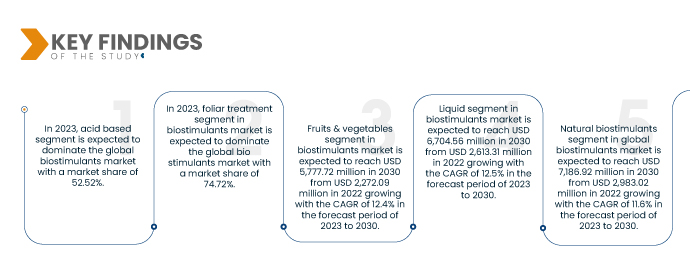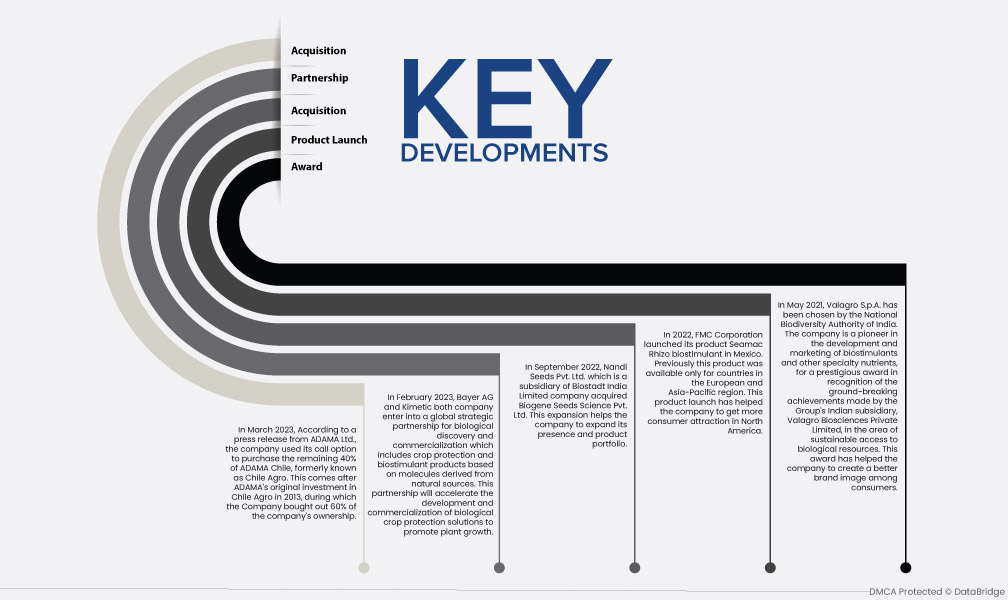Biostimulants are developed to help farmers in order to meet increased agricultural demand on a sustainable basis. Biostimulants boost crop yield and its value, which positively affects farm productivity. Agricultural biostimulant is comprised of multiple amalgamations of chemicals, substances, and micro-organisms that are added to the plants or soils to boost crop vigor, production, sensitivity to abiotic pressure, and quality. Biostimulants support the growth and production of crops throughout the entire crop life cycle, from seed germination to plant maturity, in a variety of demonstrated ways like regulating plant metabolism. Biostimulants are developed for farmers to meet the demand for sustainable agriculture including quality and improved crop yield, and even for the consumers to meet the demand for organic products so as to cope with health and safety standards. Thus, due to this, investors are increasingly interested in the biostimulant category with respect to the significant growth potential.
Access Full Report at https://www.databridgemarketresearch.com/jp/reports/global-biostimulants-market
Biostimulants work via altered mechanisms than fertilizers, regardless of the availability of nutrients in the product. It can vary from crop safety products as they work purely on the plant’s productivity and do not have any harmful action against insects or diseases. Plant biostimulation is therefore related to plant health and crop safety.
Data Bridge Market Research analyses that the Global Biostimulants Market is expected to grow at a CAGR of 11.9% in the forecast period of 2023 to 2030 and is expected to reach USD 10,176.95 million by 2030. Growing demand for sustainable coating is creating a new opportunity for the global biostimulants market to grow in the upcoming years.
Key Findings of the Study
Increasing need for sustainable agriculture is expected to drive the market for biostimulants
Sustainable agriculture is a current need for growing healthy food for people to protect the health of the plant and preserve the livelihoods of local communities. It restores the soil fertility and provides nourishment to them. Factors like climatic changes and the growing population is creating stress on the agricultural sector to ensure that customers must have sustainable food with good quality.
- In the upcoming years, agriculture may meet twin challenges such as feeding a growing global population and environmental impact. In order to reduce such challenges, new farming practices are introduced so as to overcome this. Biostimulant is being introduced as one of the promising and innovative methods in the market that helps farmers to produce more food in a sustainable way.
To overcome such challenges, one of the most promising and innovative technologies that have been introduced in the market is a biostimulant that helps farmers to produce more food in a sustainable way. It includes the usage of components such as natural substances and/or microorganisms and shows the same effect as fertilizer and pesticide. It does not cause harm to nature and is able to promote plant growth and yield high quality crops.
Hence, biostimulant is required for sustainable agriculture as it offers various benefits in terms of high crop productivity and maintenance of soil fertility. It even increases tolerance and recovers plants from abiotic stress when crops undergo uncertain climatic changes such as extreme temperature, irregular rainfall, and other stressful conditions. Biostimulant too prevents nutrients and minerals from leaching and translocation to other ecosystems. It provides an additional boost to crop growth and productivity and also allows crops to absorb nutrients and more water.
Biostimulant has a major impact on plant production by providing shoot and bud growth, root mass and lateral root development, pollen tube growth, seed and pollen germination, chlorophyll performance, and photosynthesis. It adds to the quality of products, including sugar content, color, fruit quality, firmness, and nutrient uptake, which in return can benefit the farmers in terms of income and give more nutritious food to customers. Furthermore, it also helps in the growth of beneficial soil microorganisms which improves soil fertility and prevents soil erosion.
Thus, the rise in demand for sustainable agriculture is generating the need for biostimulants in order to meet the demand for nutritious food from consumers with minimal impact on the environment. As a result, biostimulant for sustainable agriculture is expected to act as a driving factor for the growth of the global biostimulants market.
Report Scope and Market Segmentation
|
Report Metric
|
Details
|
|
Forecast Period
|
2023 to 2030
|
|
Base Year
|
2022
|
|
Historic Years
|
2021 (Customizable to 2016 - 2020)
|
|
Quantitative Units
|
Revenue in Million, Volumes in Units, and Pricing in USD
|
|
Segments Covered
|
Active Ingredients (Acid Based, Extract Based, Protein Hydrolysates, Microbial Amendments, Chitin, Chitosan, B-Vitamins, and Others), Crop Type (Fruits & Vegetables, Cereals & Grains, Oilseeds & Pulses, Turf & Ornamentals, and Other Crops), Application Method (Foliar Treatment, Soil Treatment, and Seed Treatment), Form (Liquid and Dry), End User (Farmers, Related Industries, and Research Institutes), Origin (Natural Biostimulants and Synthetic Biostimulants), Distribution Channel (Direct and Indirect)
|
|
Countries Covered
|
U.S., Canada, Mexico, Germany, France, Italy, Spain, U.K., Russia, Switzerland, Portugal, Belgium, Netherlands, Rest of Europe, Japan, China, South Korea, India, Singapore, Thailand, Indonesia, Malaysia, Philippines, Australia Rest of Asia-Pacific, Brazil, Argentina, and Rest of South America, South Africa, United Arab Emirates, Egypt, Saudi Arabia, Israel and Rest of Middles East and Africa.
|
|
Market Players Covered
|
FMC Corporation (Philadelphia, U.S.), Syngenta (Basel, Switzerland), Lallemand Inc. (Ontario, Canada), Haifa Negev Technologies LTD (Haifa, Israel), Valagro S.p.A. (Atessa, Italy), ADAMA (Beijing, China), ASL (Nova Scotia, Canada), Agrinos (Oslo, Norway), ATLÁNTICA AGRÍCOLA (Villena, Spain), Bayer AG (Leverkusen, Germany), Biolchim SPA (Bologna, Italy), Biostadt India Limited. (Mumbai, India), Brandt, Inc. (Illinois, U.S.), KOPPERT (Netherlands, Europe), MPH (England, U.K.), Novozymes (Bagsvaerd, Denmark), OMEX (Lincolnshire, England), and Trade Corporation International (Madrid, Spain) among others
|
|
Data Points Covered in the Report
|
In addition to the insights on market scenarios such as market value, growth rate, segmentation, geographical coverage, and major players, the market reports curated by the Data Bridge Market Research also include depth expert analysis, patient epidemiology, pipeline analysis, pricing analysis, and regulatory framework
|
Segment Analysis:
The global biostimulants market is segmented into seven notable segments which are based on the basis of active ingredients, crop type, application method, form, origin, end user, and distribution channel.
- On the basis of active ingredients, the global biostimulants market is segmented into acid based, extract based, microbial amendments, protein hydrolysates, B-vitamins, chitin, chitosan, and others.
In 2023, the acid based segment is expected to dominate the global biostimulants market
In 2023, the acid based segment is expected to dominate the global biostimulants market with a 52.52% market share. The acid based segment is expected to dominate the global bio stimulants market due to the advantages of bio stimulant, which contains humic acid, fulvic acid, and advantages such as increases productivity and growth of the plant, enhancing the fertility of the soil, and have less harmful effects on the ecosystem.
- On the basis of crop type, the global biostimulants market is segmented into fruits & vegetables, cereals & grains, turf & ornamentals, oilseeds & pulses, and other crops.
In 2023, the fruits & vegetables segment is expected to dominate the global biostimulants market
In 2023, the fruits & vegetables segment is expected to dominate the global biostimulants market with a 55.06% market share. The fruits & vegetables segment is expected to dominate the global biostimulants market due to the high production of fruits and vegetables globally. Farmers are focused on producing varied types of fruits and vegetables to fulfill the growing demand of consumers.
- On the basis of the application method, the global biostimulants market is segmented into foliar treatment, soil treatment, and seed treatment. In 2023, the foliar treatment segment is expected to dominate the global bio stimulants market with a 74.72% market share.
- On the basis of form, the global biostimulants market is segmented into liquid and dry. In 2023, the liquid segment is expected to dominate the global biostimulants market with a 63.40% market share.
- On the basis of end user, global biostimulants market is segmented into farmers, related industries, and research institutes. In 2023, the farmers segment is expected to dominate the global bio stimulants market with a 61.59% market share.
- On the basis of origin, the global biostimulants market is segmented into natural biostimulants and synthetic biostimulants. In 2023, the natural biostimulants segment is expected to dominate the global biostimulants market with a 71.79% market share.
- On the basis of distribution channel, the global biostimulants market is segmented into direct, and indirect. In 2023, the direct segment is expected to dominate the global bio stimulants market with a 64.12% market share.
Major Players
Data Bridge Market Research recognizes the following companies as the major market players in the global biostimulants market are FMC Corporation (Philadelphia, U.S.), Syngenta (Basel, Switzerland), Lallemand Inc. (Ontario, Canada), Haifa Negev Technologies LTD (Haifa, Israel), Valagro S.p.A. (Atessa, Italy), ADAMA (Beijing, China), ASL (Nova Scotia, Canada), Agrinos (Oslo, Norway), ATLÁNTICA AGRÍCOLA (Villena, Spain), Bayer AG (Leverkusen, Germany), Biolchim SPA (Bologna, Italy), Biostadt India Limited. (Mumbai, India), Brandt, Inc. (Illinois, U.S.), KOPPERT (Netherlands, Europe), MPH (England, U.K.), Novozymes (Bagsvaerd, Denmark), OMEX (Lincolnshire, England), and Trade Corporation International (Madrid, Spain) among others.
Recent Developments
- In March 2023, According to a press release from ADAMA Ltd., the company used its call option to purchase the remaining 40% of ADAMA Chile, formerly known as Chile Agro. This comes after ADAMA's original investment in Chile Agro in 2013, during which the Company bought out 60% of the company's ownership.
- In February 2023, Bayer AG and Kimetic both company enter into a global strategic partnership for biological discovery and commercialization which includes crop protection and biostimulant products based on molecules derived from natural sources. This partnership will accelerate the development and commercialization of biological crop protection solutions to promote plant growth.
- In September 2022, Nandi Seeds Pvt. Ltd. which is a subsidiary of Biostadt India Limited Company acquired Biogene Seeds Science Pvt. Ltd. This expansion helps the company to expand its presence and product portfolio.
- In 2022, FMC Corporation launched its product Seamac Rhizo biostimulant in Mexico. Previously this product was available only for countries in the European and Asia-Pacific region. This product launch has helped the company to get more consumer attraction in North America.
- In May 2021, Valagro S.p.A. has been chosen by the National Biodiversity Authority of India. The company is a pioneer in the development and marketing of biostimulants and other specialty nutrients, for a prestigious award in recognition of the ground-breaking achievements made by the Group's Indian subsidiary, Valagro Biosciences Private Limited, in the area of sustainable access to biological resources. This award has helped the company to create a better brand image among consumers.
Regional Analysis
Geographically, the countries covered in the global biostimulants market are U.S., Canada, Mexico, Germany, France, Italy, Spain, U.K., Russia, Switzerland, Portugal, Belgium, Netherlands, Rest of Europe, Japan, China, South Korea, India, Singapore, Thailand, Indonesia, Malaysia, Philippines, Australia Rest of Asia-Pacific, Brazil, Argentina, and Rest of South America, South Africa, United Arab Emirates, Egypt, Saudi Arabia, Israel and Rest of Middles East and Africa.
As per Data Bridge Market Research analysis:
Europe is the dominant region in the global biostimulants market during the forecast period of 2023-2030
- In 2023, Europe is expected to dominate the global biostimulants market due to the presence of a large number of operating major players in the region and the increase in initiatives such as acquisitions, collaborations, and product launch by manufacturers to distribute their products efficiently to the consumer.
Asia-Pacific is the fastest growing region in the global biostimulants market during the forecast period of 2023-2030
- In 2023, the Asia-Pacific is expected to be the fastest growing region in the global biostimulants market growing with the highest CAGR of 12.5% in the forecast period of 2023 to 2030.
For more detailed information about the global biostimulants market report, click here – https://www.databridgemarketresearch.com/jp/reports/global-biostimulants-market














